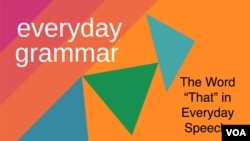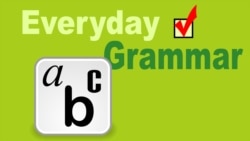The 1994 crime film "Pulp Fiction" tells the story of a gunman, played by Samuel L. Jackson.
In the film, the gunman is growing tired of his life of crime. Near the end of the movie, he gives two other criminals a chance to leave a bad situation.
-“The truth is, you're the weak and I'm the tyranny of evil men. But I'm tryin', Ringo. I'm tryin' real hard to be the shepherd. Go."
- "I think we should be leaving now."
- "Yeah. That's probably a good idea."
In this program, we explore the meaning of a word you heard in the recording: the pronoun “that”. And we will look at how Americans use this word in everyday speech. You might be surprised how often Americans use it for different purposes!
The word "that"
On another Everyday Grammar program, we explored the many uses of the word "that." That belongs to a group of words called demonstratives. Sometimes demonstratives act as pronouns. When acting as pronouns, they suggest that nouns are either close to the speaker or far away.*
In American English, speakers use the word "that" to mean people or objects that are at a distance. But they also use it in other ways.
For example, English speakers often use the word "that" to give an opinion about something or to repeat the main points of a conversation.
We will now look at each of these uses in greater detail.
#1 Evaluating an idea or situation
Speakers often use the word "that" in sentences that give an opinion about an idea or situation. They do this by using the structure, that's + an adjective, or that's + a noun phrase.
This audio from the 1996 film "Fargo" gives an example of the first structure:
- "They announced it."
- "They announced it?"
- "Yah."
- "So?"
- "Three-cent stamp."
- "Your mallard?"
- "Yah."
- "Oh, that's terrific."
The term "that's terrific" is an example of that's + an adjective. Here, the word "that" means the idea or situation presented; in other words, the new stamp. The adjective "terrific" gives the speakers positive or good opinion about the stamp.
There are any number of adjectives that speakers use to express their opinion. A few other examples are "that's cool" or "that's awesome," two common expressions among younger Americans.
English speakers also use the that's + a noun clause structure to give an opinion about a situation or idea.
Think back to the lines you heard at the beginning of this program.
- "I think we should be leaving now."
- "Yeah. That's probably a good idea."
Here, the word "that" means the idea that came in the earlier sentence "I think we should be leaving now."
The speaker gives his opinion about the idea by using the noun phrase "a good idea." The word "probably" changes the force of his statement.
#2 Summarizing the main point of earlier statements
The second common structure in everyday speech is that's + a wh- clause. A wh- clause suggests a group of words beginning with the letters w and h, such as why or what.
Speakers use this structure when they are noting the main points of earlier statements in a conversation.
The comedy film "Clerks" has an example of how speakers use this structure in everyday speech. Here, the actors are having a debate about the best "Star Wars" movie:
“Empire had the better ending. I mean, Luke gets his hand cut off, finds out Vader's his father, Han gets frozen and taken away by Boba Fett. It ends on such a down note. I mean, that's what life is, a series of down endings."
The main speaker makes several statements and then closes with the words "that's what life is – a series of down endings." The word "that" means the ideas presented earlier: namely, a series of bad events. Hopefully, you do not agree with the speaker's opinions of life!
What can you do?
Instead of giving you a down ending – such as in the line from the film Clerks – we are going to end on a positive note.
Learning and understanding the uses of pronouns such as "that" can be difficult. But, you will be successful if you take a few simple steps.
The next time you are watching a film or talking with English speakers, try to listen for examples of the word "that."
Ask yourself the following questions: Do the speakers use it to give their opinion? Do they use it to summarize the conversation?
Then, find a person to practice with. Try to use the word "that" when speaking to them.
Let us know if you have any questions – we are always happy to help!
I'm Alice Bryant.
And I'm John Russell.
John Russell wrote this story for Learning English. George Grow was the editor.
*The word "that" can also introduce adjective clauses. These types of clauses are beyond the scope of this story.
We want to hear from you. Write to us in the Comments Section.
_____________________________________________________________
Words in This Story
demonstrative – n. a word (such as “this,” “that,” “these,” or “those”) that tells who or what is being spoken about
conversation – n. a talk involving two people or a small group of people; a discussion
phrase – n. a group of two or more words that express a single idea but do not usually form a complete sentence
clause – n. grammar a part of a sentence that has its own subject and verb
tyranny – n. an oppressive power
pronoun – n. a word that is used instead of a noun
stamp – n. a small piece of paper placed on something to show that a payment has been made
mallard – n. a common duck
comedy – adj. something that is meant to make people laugh
practice – v. to perform repeatedly; to train








